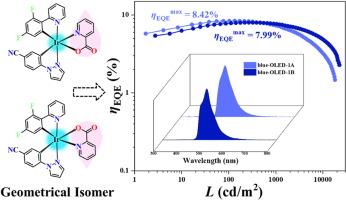Geometrically isomeric [Ir(C^N)(C’^N’)(N’’^O)-tris-heteroleptic [Ir(dFppy)(CN-ppz)(pic)] Ir(III)-complexes with blue-light: Forwards to efficient blue organic light-emitting diodes
IF 3.3
3区 物理与天体物理
Q2 OPTICS
引用次数: 0
Abstract
Despite the great success of Ir(III)-complex-based green/red-light OLEDs (OLED = organic light-emitting diode), the realization of their efficient blue-OLEDs is far behind and challenging. Herein, using HdFppy (2-(2,4-difluorophenyl)pyridine) and CN-ppzH (4-(1H-pyrazol-1-yl)benzonitrile) as the HC^N/HC’^N’ ligands and Hpic (2-picolinic acid) as the N’’^O-ancillary ligand, the [Ir(C^N)(C’^N’)(N’’^O)]-tris-heteroleptic molecular design strategy was adopted, obtaining the two [Ir(dFppy)(CN-ppz)(pic)]-configured blue-emitting (λPL (photoluminescence emission peak) = 466, 496(sh) nm; ΦPL (photoluminescence quantum efficiency) = 0.41–0.46) geometrical isomers 1a and 1b. Further through the doped and vacuum-deposited fabrication, their blue-OLEDs-1A/1B with the LMax (maximum luminance) values up to 18090–22528 cd/m2 and the ηEQEMax (maximum external quantum efficiency) sizes of 7.99–8.42 %, were realized, respectively. This study result shows that [Ir(dFppy)(CN-ppz)(pic)]-included [Ir(C^N)(C’^N’)(N’’^O)]-tris-heteroleptic Ir(III)-complexes can be used as the attractive blue-phosphor candidates forwards to efficient blue-OLEDs.

具有蓝光的几何异构[Ir(C^N)(C'^N')(N''^O)-三杂环[Ir(dFppy)(CN-ppz)(pic)]Ir(III)-络合物:向高效蓝色有机发光二极管迈进
尽管基于Ir(III)络合物的绿光/红光有机发光二极管(OLED = 有机发光二极管)取得了巨大成功,但其高效蓝光有机发光二极管的实现却远远落后,且极具挑战性。本文以 HdFppy(2-(2,4-二氟苯基)吡啶)和 CN-ppzH(4-(1H-吡唑-1-基)苯腈)作为 HC^N/HC'^N' 配体,以 Hpic(2-吡啶甲酸)作为 N''^O-ancillary 配体、采用[Ir(C^N)(C'^N')(N''^O)]三杂环分子设计策略,得到了两种[Ir(dFppy)(CN-ppz)(pic)]配置的蓝色发光体(λPL(光致发光发射峰)=466、496(sh)纳米;ΦPL(光致发光量子效率)= 0.41-0.46)的几何异构体 1a 和 1b。进一步通过掺杂和真空沉积制造,它们的蓝色有机发光二极管-1A/1B 的 LMax(最大亮度)值分别达到 18090-22528 cd/m2,ηEQEMax(最大外部量子效率)大小为 7.99-8.42%。该研究结果表明,[Ir(dFppy)(CN-ppz)(pic)]-包含[Ir(C^N)(C'^N')(N''^O)]-三杂环Ir(III)-络合物可作为具有吸引力的蓝光荧光体候选物,用于制造高效的蓝光有机发光二极管。
本文章由计算机程序翻译,如有差异,请以英文原文为准。
求助全文
约1分钟内获得全文
求助全文
来源期刊

Journal of Luminescence
物理-光学
CiteScore
6.70
自引率
13.90%
发文量
850
审稿时长
3.8 months
期刊介绍:
The purpose of the Journal of Luminescence is to provide a means of communication between scientists in different disciplines who share a common interest in the electronic excited states of molecular, ionic and covalent systems, whether crystalline, amorphous, or liquid.
We invite original papers and reviews on such subjects as: exciton and polariton dynamics, dynamics of localized excited states, energy and charge transport in ordered and disordered systems, radiative and non-radiative recombination, relaxation processes, vibronic interactions in electronic excited states, photochemistry in condensed systems, excited state resonance, double resonance, spin dynamics, selective excitation spectroscopy, hole burning, coherent processes in excited states, (e.g. coherent optical transients, photon echoes, transient gratings), multiphoton processes, optical bistability, photochromism, and new techniques for the study of excited states. This list is not intended to be exhaustive. Papers in the traditional areas of optical spectroscopy (absorption, MCD, luminescence, Raman scattering) are welcome. Papers on applications (phosphors, scintillators, electro- and cathodo-luminescence, radiography, bioimaging, solar energy, energy conversion, etc.) are also welcome if they present results of scientific, rather than only technological interest. However, papers containing purely theoretical results, not related to phenomena in the excited states, as well as papers using luminescence spectroscopy to perform routine analytical chemistry or biochemistry procedures, are outside the scope of the journal. Some exceptions will be possible at the discretion of the editors.
 求助内容:
求助内容: 应助结果提醒方式:
应助结果提醒方式:


